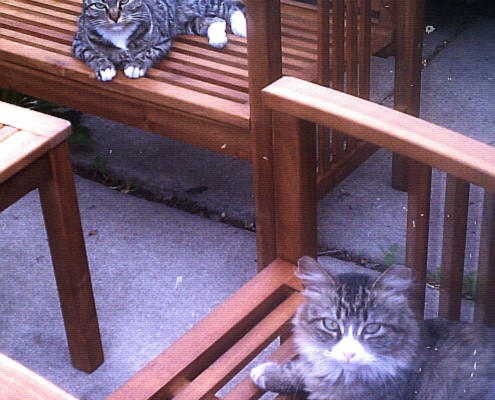June 5, 2015
Since moving to the Albany Park neighborhood over 4 years ago, I’ve noticed that there are a few standout aspects that make this Northwest-side neighborhood unique (in no particular order): fantastic falafel, the North Branch of the Chicago River, the CTA Brown Line running at street level backing up traffic, and lots of outdoor cats roaming the streets.
It is tough to imagine being an outdoor cat enduring the Chicago winters, but there are an estimated 500,000 feral cats living in Chicago, and 60 million nationwide. It wasn’t something to which I gave much thought, until one afternoon in the fall of 2011. In our back yard, from under some evergreen bushes, four fluffy kittens were starting to venture out and explore. They stayed within meowing-distance from their mother, a small shorthaired brown tabby with white back legs that we started calling “Mama,” for obvious reasons. We hadn’t noticed any cats coming or going in the area before, but suddenly we had a handful of them. We thought they were adorable and put out a little cheese and turkey for them. This was just the beginning.
We soon realized that these were not escaped housecats, but wild animals who were not socialized to people.
 Another adult cat started coming around during feeding time. We dubbed this one “Tommy.” We wanted them to be safe and healthy, but as ferals, we knew it would be difficult to care for them. They were terribly afraid of us, yet they hung around as long as we kept putting out food. Unsocialized cats generally will not allow human contact and will not eat while in the vicinity of humans. We spent some time researching what to do to help them survive, and with winter coming, we knew we needed to help them soon.
Another adult cat started coming around during feeding time. We dubbed this one “Tommy.” We wanted them to be safe and healthy, but as ferals, we knew it would be difficult to care for them. They were terribly afraid of us, yet they hung around as long as we kept putting out food. Unsocialized cats generally will not allow human contact and will not eat while in the vicinity of humans. We spent some time researching what to do to help them survive, and with winter coming, we knew we needed to help them soon.
The best resource we found is a website for a local no-kill cat-only shelter in Chicago called Treehouse. In addition to putting pet cats into loving homes, they have a program known as TNR for “community cats.” TNR stands for “Trap-Neuter-Return.” This program allows cat colony caretakers like us some control over the population of wild cats, and to have their cats vaccinated. Unfortunately, there are too many cats to take in every feral that is outside. We later learned that the policy for Chicago Animal Care and Control is to euthanize feral cats that are brought in after only a short waiting period because they are so difficult to re-home. And while it is possible to socialize feral cats, they often do not take to being permanent indoor cats. Getting a feral cat into the shelter system is surprisingly difficult. Even the no-kill shelters will not accept a feral, because they are generally unable to connect with the people who are potential adopters. We had to make a plan to protect these furball friends.
We decided to trap the kittens and attempt to get them adopted into new homes. The kind folks at Treehouse told us that at the kitten stage, they can more easily be socialized with people and become friendly normal house pets. (Trapping the kittens and getting them into shelters is another long story for another blog post). Having already adapted to outdoor survival, the adult cats were more afraid of us, so our plan was to get them vaccinated, fixed, and let them live in our yard while feeding and slowly socializing them from a distance.
We participated in Treehouse’s TNR program with “Mama” and “Tommy.” You may rent a humane trap for a $60 deposit (which is returned when you bring back the trap) that you can set up with any kind of food for bait. It worked like a charm… the first time. With both cats unhappily trapped and ready to go, we took them in to the Bucktown location and dropped them off with the in-house vet. They received a series of vaccinations, their ears were tipped so that they would be recognized as “community cats,” they were micro-chipped, and both were spayed (it was at this time that “Tommy” was discovered to be a female, and probably Mama’s littermate instead of her kitten-daddy as we previously thought). We changed her name to the more feminine “Tommie,” but we don’t think she cares either way.
When we picked the cats up later that day, they had been put back in the traps. We kept them indoors in the traps for a few days, providing food, water and shelter until they were fully recovered from their surgeries. Then we brought them back out to the yard where they could continue to live happy lives. Little did we know how great the impact of these two flea bag ferals would be on our lives.
Stay tuned for Part Two, coming soon!
Nick manages our dog walking team at Rover-Time. He lives with his wife in Albany Park and together they share one Australian cattle dog mix named Squirrely, a parakeet named Pierre, and two cats who were originally feral but later came to live inside and become socialized.

Recent Comments